|
|
|
|
|
|
||
|
Divisions of HIV/AIDS Prevention |
|||||||
| Slide Sets | Home | Index | Search | Site Map | Subscribe | Contact Us |
Pediatric HIV/AIDS Surveillance
L262 slide series
(through 2001)
Download complete set (12 slides) in PDF format (Adobe Acrobat v5.0 or higher) - (538 KB)
Download complete set (12 slides) in PPT format (PowerPoint 2002 required) - (387 KB)
NOTE: These
slides are in the public domain and may be used without special permission.
See "Instructions for Downloading and
Using HIV/AIDS surveillance slides".
Adobe Acrobat (TM) Reader v5.0 or higher needs to be installed on your computer
in order to be able to read the slides in Adobe PDF (Portable Document Format).
Download the Adobe Acrobat (TM) Reader
 |
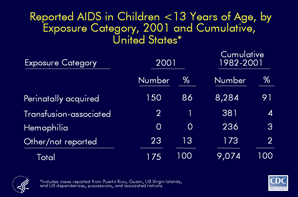 |
| Slide #1 Mother’s Exposure Category, by Year of Diagnosis for Perinatally Acquired AIDS, 1981- 2000, United States |
Slide #2 Reported AIDS in Children <13 Years of Age, by Exposure Category, 2001 and Cumulative, United States |
| Zoom/Download Slide #1 | Zoom/Download Slide #2 |
![Slide 3 - Title:
Perinatally Acquired AIDS Cases, by Year of Diagnosis, 1985 - 2000, United States
The estimated number of AIDS cases diagnosed among persons perinatally exposed to HIV peaked in 1992 and has decreased in recent years.
The decline of these cases is likely associated with the implementation of Public Health Service guidelines for the universal counseling and voluntary HIV testing of pregnant women and the use of antiretroviral therapy for pregnant women and newborn infants (MMWR 2002;51[No. RR-18]). Other contributing factors are the effective treatment of HIV infections that slow progression to AIDS and the use of prophylaxis to prevent AIDS opportunistic infections among children.](/peth04/20041027002917im_/http://www.cdc.gov/hiv/graphics/images/l262/l262_3s.gif) |
 |
| Slide #3 Perinatally Acquired AIDS Cases, by Year of Diagnosis, 1985 - 2000, United States |
Slide #4 Zidovudine Use for HIV-infected Pregnant Women or for Perinatally Exposed or Infected Children Born 1993-2000, 39 States |
| Zoom/Download Slide #3 | Zoom/Download Slide #4 |
 |
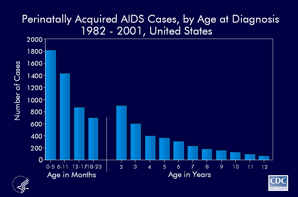 |
| Slide #5 AIDS Cases in Children Reported in 2001 |
Slide #6 Perinatally Acquired AIDS Cases, by Age at Diagnosis, 1982 - 2001, United States |
| Zoom/Download Slide #5 | Zoom/Download Slide #6 |
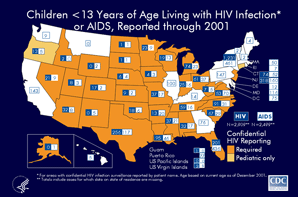 |
 |
| Slide #7 Children <13 Years of Age Living with HIV Infection or AIDS, Reported through 2001 |
Slide #8 AIDS-defining Conditions Most Commonly Reported for Children <13 Years of Age, Reported through 2001, United States |
| Zoom/Download Slide #7 | Zoom/Download Slide #8 |
 |
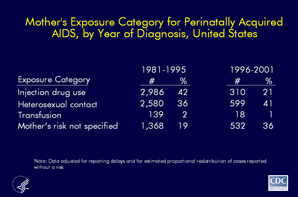 |
| Slide #9 AIDS-defining Conditions, by Age at Diagnosis for Perinatally Acquired AIDS Cases, Reported through 2001, United States |
Slide #10 Mother’s Exposure Category for Perinatally Acquired AIDS, by Year of Diagnosis, United States |
| Zoom/Download Slide #9 | Zoom/Download Slide #10 |
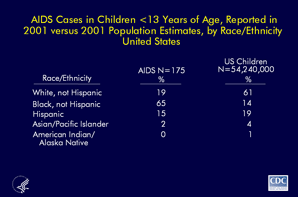 |
 |
| Slide #11 AIDS in Children <13 Years of Age, Reported in 2001 versus 2001 Population Estimates, by Race/Ethnicity, United States |
Slide #12 AIDS Rates (cases per 100,000) for Children <13 Years of Age, by Race/Ethnicity, Reported in 2001, United States |
| Zoom/Download Slide #11 | Zoom/Download Slide #12 |
